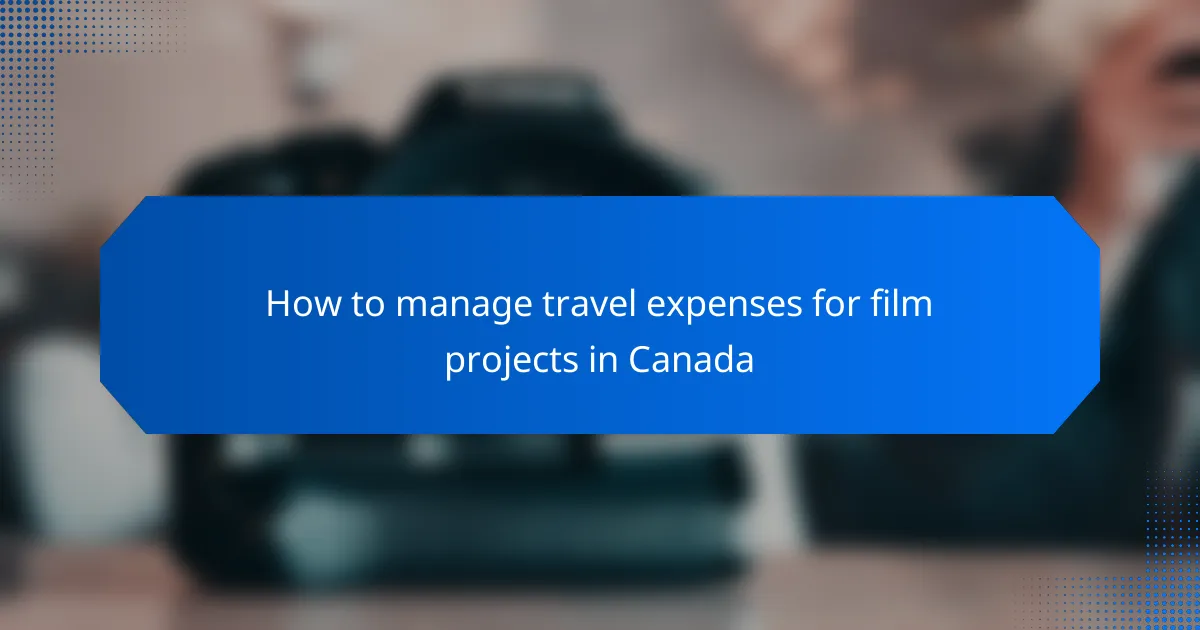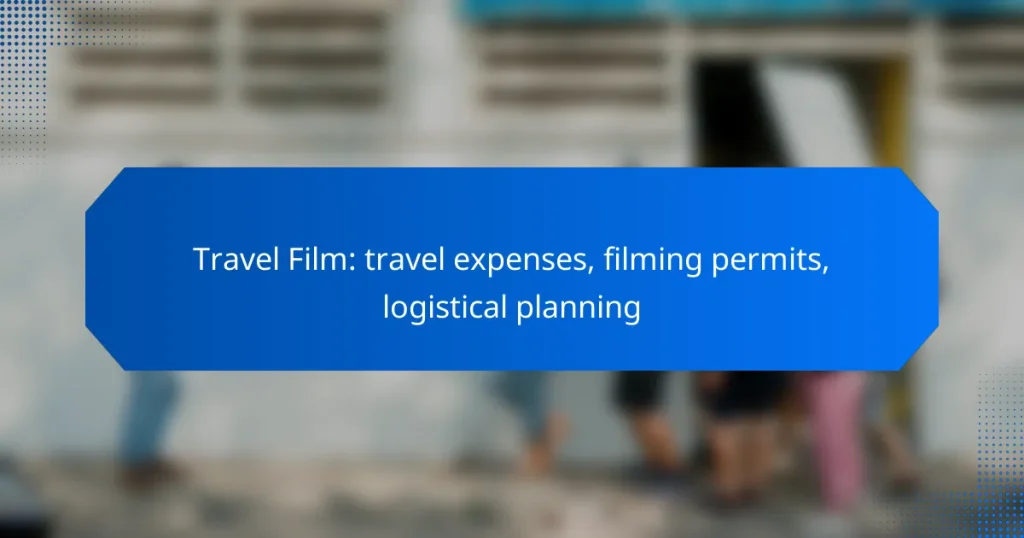When embarking on a travel film project in Canada, meticulous management of travel expenses and logistical planning is crucial for success. Filmmakers must budget for transportation, accommodation, meals, and essential filming permits to navigate local regulations and minimize disruptions. Proper coordination of resources and adherence to permit requirements will facilitate a smoother production experience.

How to manage travel expenses for film projects in Canada
Managing travel expenses for film projects in Canada involves careful planning and budgeting. Filmmakers should account for transportation, accommodation, meals, and filming permits to ensure a smooth production process.
Budgeting tools for filmmakers
Filmmakers can utilize various budgeting tools to effectively manage their travel expenses. Software like Movie Magic Budgeting and StudioBinder helps in creating detailed budgets that include all necessary costs. These tools allow users to categorize expenses and track them against the budget throughout the project.
Additionally, using spreadsheets can be a simple yet effective way to outline costs. Creating a budget template that includes line items for travel, lodging, and permits can help keep finances organized and transparent.
Average costs for filming locations
The average costs for filming locations in Canada can vary significantly depending on the province and type of location. Urban areas like Toronto and Vancouver may charge higher fees, often ranging from CAD 1,000 to CAD 5,000 per day for popular sites. In contrast, rural locations might offer more affordable options, sometimes under CAD 1,000 per day.
Filmmakers should also consider additional costs such as permits, insurance, and location fees, which can add up quickly. Researching local regulations and contacting location managers can provide clarity on potential expenses.
Expense tracking apps
Expense tracking apps can streamline the process of managing travel costs during film projects. Apps like Expensify and QuickBooks allow filmmakers to log expenses in real-time, making it easier to stay within budget. These apps often feature receipt scanning and categorization, which simplifies the tracking process.
Choosing an app that integrates with accounting software can further enhance financial management. Filmmakers should regularly update their expense reports to avoid surprises at the end of the project and ensure all costs are accounted for.

What filming permits are required in Canada?
In Canada, filming permits are essential for any production that takes place in public spaces or on private property. These permits ensure compliance with local regulations and help manage the impact of filming on the community.
Types of filming permits
There are generally two main types of filming permits in Canada: municipal and provincial permits. Municipal permits are required for filming in city-owned locations, while provincial permits may be necessary for filming in provincial parks or on government property.
Additionally, special permits may be needed for specific activities, such as drone filming or using special effects. Each province may have its own requirements, so it’s crucial to check local regulations.
Application process for permits
The application process for filming permits typically involves submitting a detailed request to the relevant authority, which may include a description of the project, filming locations, and a proposed schedule. It’s advisable to apply well in advance, often several weeks to months before the planned shoot.
Some municipalities may require a public notification process, where local residents are informed about the filming. This can help mitigate concerns and facilitate smoother operations during the shoot.
Cost of filming permits
The cost of filming permits in Canada can vary widely depending on the location and the scope of the project. Municipal permits may range from a few hundred to several thousand Canadian dollars, while provincial permits might have different fee structures.
Additional costs may arise from insurance requirements, road closures, or the need for additional city services. It’s essential to budget for these potential expenses to avoid surprises during the filming process.

How to plan logistics for filming in Canada
Planning logistics for filming in Canada involves careful coordination of resources, transportation, and accommodations to ensure a smooth production process. Key considerations include obtaining necessary filming permits, managing travel expenses, and utilizing effective logistical planning tools.
Logistical planning software
Using logistical planning software can streamline the organization of your film project in Canada. These tools help manage schedules, track expenses, and coordinate team communications. Popular options include Movie Magic Scheduling and StudioBinder, which offer features tailored to film production needs.
When selecting software, consider user-friendliness and integration capabilities with other tools you may be using. A good platform can save time and reduce errors, making it easier to stay on budget and on schedule.
Transportation options for crew
Transportation for your crew is a critical aspect of logistical planning in Canada. Depending on your filming locations, options may include rental vans, buses, or even local transport services. Ensure that your transportation choices accommodate the size of your crew and the equipment being moved.
For remote locations, consider hiring a local transport service familiar with the area. This can help avoid delays and ensure that your crew arrives safely and on time. Always account for potential weather-related disruptions, especially in winter months.
Accommodation strategies for film crews
Finding suitable accommodation for your film crew is essential for maintaining productivity. Look for options that can house your entire team close to filming locations, such as hotels, motels, or vacation rentals. Booking well in advance can help secure the best rates and availability.
Consider negotiating group rates with hotels or exploring local rental properties that offer kitchen facilities to save on meal costs. Additionally, ensure that accommodations provide necessary amenities, such as Wi-Fi and workspace, to support your crew’s needs during production.

What are the best practices for budgeting in film production?
Effective budgeting in film production involves careful planning and precise forecasting of all costs associated with the project. Key practices include detailed cost estimation, tracking expenses, and preparing for unforeseen financial challenges.
Cost estimation techniques
Cost estimation techniques are essential for creating an accurate film budget. Common methods include bottom-up estimating, where each component of the production is assessed individually, and analogous estimating, which uses data from previous projects as a reference. For instance, if a similar film had a budget of around $500,000, you might use that figure to guide your current project.
Utilizing software tools can enhance accuracy in cost estimation. Many filmmakers rely on budgeting software that allows for real-time adjustments and collaboration among team members. This ensures all expenses, from equipment rentals to location fees, are accounted for effectively.
Contingency planning for unexpected expenses
Contingency planning is crucial for managing unexpected expenses in film production. A common practice is to allocate 10-20% of the total budget as a contingency fund. This reserve can cover unforeseen costs such as equipment damage, location changes, or additional permits required during filming.
Regularly reviewing and updating the budget throughout the production process helps identify potential financial risks early. Filmmakers should maintain open communication with all departments to ensure everyone is aware of the budget constraints and can adapt as needed. This proactive approach minimizes the impact of unexpected costs on the overall project budget.

How to choose filming locations in Canada?
Choosing filming locations in Canada involves considering factors like accessibility, scenery, and local regulations. The diverse landscapes and urban settings across provinces provide a wealth of options, but understanding the logistical requirements is essential for a smooth production process.
Popular filming locations in Canada
Canada boasts numerous popular filming locations, including cities like Vancouver, Toronto, and Montreal, each offering unique backdrops. The stunning natural scenery of Banff National Park and the historic architecture of Quebec City are also frequently sought after for their visual appeal.
In addition to urban and natural settings, the Canadian film industry often utilizes iconic sites such as the Parliament Buildings in Ottawa and the rugged coastlines of Newfoundland. These locations not only enhance the storytelling but also attract potential funding and support from local film commissions.
Location scouting tips
When scouting locations in Canada, prioritize accessibility and local regulations. Ensure that the site can accommodate your crew and equipment, and check for any necessary filming permits or restrictions that may apply in the area.
Utilize local resources, such as film commissions, which can provide valuable insights and assistance in navigating the permitting process. Additionally, consider visiting during different times of the year to capture the location in various seasonal contexts, which can significantly impact the visual narrative of your film.

What are the challenges of filming in remote areas?
Filming in remote areas presents unique challenges that can significantly impact production. Key issues include access and transportation difficulties, as well as communication barriers that can hinder coordination and logistics.
Access and transportation issues
Accessing remote filming locations often requires careful planning and consideration of transportation options. Depending on the terrain, you may need specialized vehicles, such as 4x4s or even helicopters, to reach your destination. It’s crucial to factor in travel time and potential delays when scheduling shoots.
Additionally, remote areas may lack established roads or infrastructure, making it essential to scout locations in advance. Always have contingency plans for transportation, including alternative routes or backup vehicles, to avoid disruptions during filming.
Communication challenges
Communication in remote locations can be problematic due to limited cell service and internet connectivity. It’s advisable to invest in satellite phones or two-way radios to maintain contact with your crew and production team. Establishing a reliable communication plan before filming can help mitigate these issues.
Moreover, consider the language barriers that may arise if filming in a region where the local language differs from your crew’s. Hiring a local translator or guide can facilitate smoother interactions and enhance collaboration with local communities.

How to navigate local regulations for filming?
Navigating local regulations for filming involves understanding the specific laws and requirements in your chosen location. This includes obtaining necessary permits, adhering to safety standards, and respecting community guidelines.
Understanding local laws
Local laws regarding filming can vary significantly by region, impacting everything from permit requirements to restrictions on public spaces. Researching these laws early in your planning process is crucial to avoid fines or delays.
Typically, you will need to apply for filming permits through local government offices, which may include city or county offices. Fees for these permits can range from a few dozen to several hundred dollars, depending on the scope of your project.
In some areas, you may also need to secure additional permissions for specific locations, such as parks or historical sites. Always check for any local ordinances that might affect your filming schedule or methods.


